Amputation
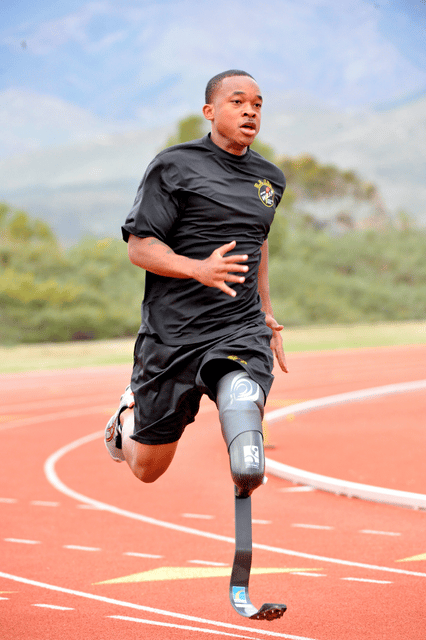
Amputation

| Amputation | |
|---|---|
| Sgt. Jerrod Fields, an athlete and amputee. | |
| Specialty | SurgeryPhysical medicine and rehabilitationEmergency medicine |
Amputation is the removal of a limb by trauma, medical illness, or surgery. As a surgical measure, it is used to control pain or a disease process in the affected limb, such as malignancy or gangrene. In some cases, it is carried out on individuals as a preventative surgery for such problems. A special case is that of congenital amputation, a congenital disorder, where fetal limbs have been cut off by constrictive bands. In some countries, amputation of the hands, feet or other body parts is or was used as a form of punishment for people who committed crimes.[1][2][3] Amputation has also been used as a tactic in war and acts of terrorism; it may also occur as a war injury. In some cultures and religions, minor amputations or mutilations are considered a ritual accomplishment.[4][5][6]
In the US, the majority of new amputations occur due to complications of the vascular system (the blood vessels), especially from diabetes. Between 1988 and 1996, there were an average of 133,735 hospital discharges for amputation per year in the US.[9] In 2005, just in the US, there were 1.6 million amputees.[10] In 2013, the US has 2.1 million amputees. Approximately 185,000 amputations occur in the United States each year. In 2009, hospital costs associated with amputation totaled more than $8.3 billion.[11] There will be an estimated 3.6 million people in the US living with limb loss by 2050.[12] African Americans are up to four times more likely to have an amputation than European Americans.[13]
| Amputation | |
|---|---|
| Sgt. Jerrod Fields, an athlete and amputee. | |
| Specialty | SurgeryPhysical medicine and rehabilitationEmergency medicine |
Types
Leg

An above-knee amputation
Lower limb amputations can be divided into two broad categories: minor and major amputations. Minor amputations generally refer to the amputation of digits. Major amputations are commonly below-knee- or above-knee amputations Common partial foot amputations include the Chopart, Lisfranc, and ray amputations.
Common forms of ankle disarticulations include Pyrogoff, Boyd, and Syme amputations.[14] A less common major amputation is the Van Nes rotation, or rotationplasty, i.e. the turning around and reattachment of the foot to allow the ankle joint to take over the function of the knee.
Types of amputations include:
- partial foot amputationamputation of the lower limb distal to the ankle jointankle disarticulationamputation of the lower limb at the ankle jointtrans-tibial amputationamputation of the lower limb between the knee joint and the ankle joint, commonly referred to as a below-knee amputationknee disarticulationamputation of the lower limb at the knee jointtrans-femoral amputationamputation of the lower limb between the hip joint and the knee joint, commonly referred to an above-knee amputationhip disarticulationamputation of the lower limb at the hip jointtrans-pelvic disarticulationamputation of the whole lower limb together with all or part of the pelvis, also known as a hemipelvectomy or hindquarter amputation
Arm
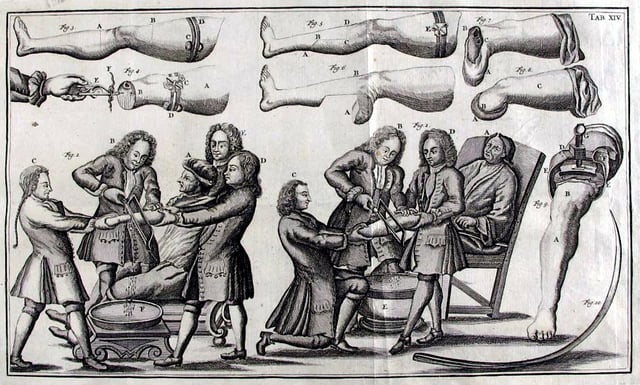
The 18th century guide to amputations
Types of upper extremity amputations include:
partial hand amputation
wrist disarticulation
trans-radial amputation, commonly referred to as below-elbow or forearm amputation
elbow disarticulation
trans-humeral amputation, commonly referred to as above-elbow amputation
shoulder disarticulation
forequarter amputation
A variant of the trans-radial amputation is the Krukenberg procedure in which the radius and ulna are used to create a stump capable of a pincer action.
Other
Facial amputations include but are not limited to: amputation of the ears amputation of the nose (rhinotomy) amputation of the tongue (glossectomy). amputation of the eyes (enucleation). amputation of the teeth. Removal of teeth, mainly incisors, is or was practiced by some cultures for ritual purposes (for instance in the Iberomaurusian culture of Neolithic North Africa).
Breasts: amputation of the breasts (mastectomy).
Genitals: amputation of the testicles (castration). amputation of the penis (penectomy). amputation of the foreskin (circumcision). amputation of the clitoris (clitoridectomy).
Hemicorporectomy, or amputation at the waist, and decapitation, or amputation at the neck, are the most radical amputations.
Genital modification and mutilation may involve amputating tissue, although not necessarily as a result of injury or disease.
Self-amputation
In some rare cases when a person has become trapped in a deserted place, with no means of communication or hope of rescue, the victim has amputated his or her own limb. The most notable case of this is Aron Ralston, a hiker who amputated his own right forearm after it was pinned by a boulder in a hiking accident and he was unable to free himself for over five days.[15]
Body integrity identity disorder is a psychological condition in which an individual feels compelled to remove one or more of their body parts, usually a limb. In some cases, that individual may take drastic measures to remove the offending appendages, either by causing irreparable damage to the limb so that medical intervention cannot save the limb, or by causing the limb to be severed.
Causes
Circulatory disorders
Diabetic vasculopathy
Sepsis with peripheral necrosis
Neoplasm
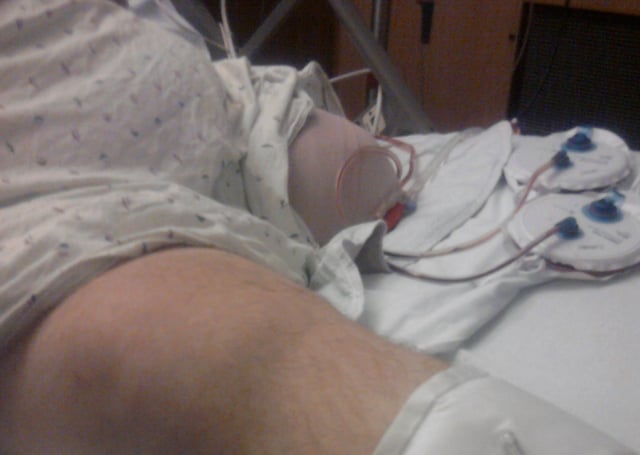
Transfemoral amputation due to liposarcoma
Cancerous bone or soft tissue tumors (e.g. osteosarcoma, chondrosarcoma, fibrosarcoma, epithelioid sarcoma, Ewing's sarcoma, synovial sarcoma, sacrococcygeal teratoma, liposarcoma), melanoma
Trauma
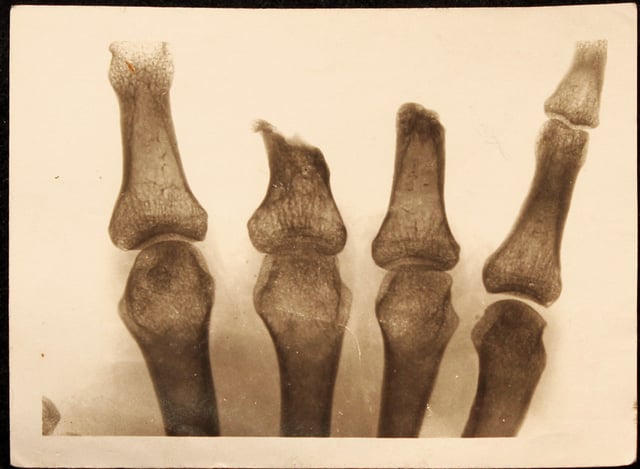
Three fingers from a soldier's right hand were traumatically amputated during World War I.
Severe limb injuries in which the limb cannot be saved or efforts to save the limb fail.
Traumatic amputation (an unexpected amputation that occurs at the scene of an accident, where the limb is partially or entirely severed as a direct result of the accident, for example, a finger that is severed from the blade of a table saw)
Amputation in utero (Amniotic band)
Congenital anomalies
Deformities of digits and/or limbs (e.g., proximal femoral focal deficiency, Fibular hemimelia)
Extra digits and/or limbs (e.g., polydactyly)
Infection
Bone infection (osteomyelitis) and/or diabetic foot infections
Frostbite
Athletic performance
Sometimes professional athletes may choose to have a non-essential digit amputated to relieve chronic pain and impaired performance.
Australian Rules footballer Daniel Chick elected to have his left ring finger amputated as chronic pain and injury was limiting his performance.[16]
Rugby union player Jone Tawake also had a finger removed.[17]
National Football League safety Ronnie Lott had the tip of his little finger removed after it was damaged in the 1985 NFL season.
Legal punishment
Amputation is used as a legal punishment in a number of countries, among them Saudi Arabia, Yemen, United Arab Emirates, and Iran.
Surgery
Method
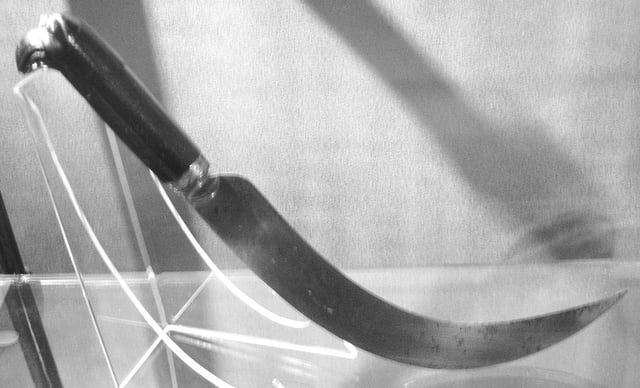
Curved knives such as this one were used, in the past, for some kinds of amputations.
The first step is ligating the supplying artery and vein, to prevent hemorrhage (bleeding). The muscles are transected, and finally, the bone is sawed through with an oscillating saw. Sharp and rough edges of the bone(s) are filed down, skin and muscle flaps are then transposed over the stump, occasionally with the insertion of elements to attach a prosthesis.
Distal stabilisation of muscles is recommended. This allows effective muscle contraction which reduces atrophy, allows functional use of the stump and maintains soft tissue coverage of the remnant bone. The preferred stabilisation technique is myodesis where the muscle is attached to the bone or its periosteum. In joint disarticulation amputations tenodesis may be used where the muscle tendon is attached to the bone. Muscles should be attached under similar tension to normal physiological conditions.[18]
In 1920, Professor Janos Ertl, Sr., MD, of Hungary, developed the Ertl procedure in order to return a high number of amputees to the work force.[21] The Ertl technique, an osteomyoplastic procedure for transtibial amputation, can be used to create a highly functional residual limb. Creation of a tibiofibular bone bridge provides a stable, broad tibiofibular articulation that may be capable of some distal weight bearing. Several different modified techniques and fibular bridge fixation methods have been used; however, no current evidence exists regarding comparison of the different techniques.[22]
Post-operative management
The use of rigid removable dressings (RRD's) in trans-tibial (below knee) amputations, rather than soft bandaging has been shown to improve healing time, reduce edema, prevent knee flexion contractures and reduce complications, including further amputation, from external trauma such as falls onto the stump[23] and should be considered standard practice.
Post-operative management, in addition to wound healing, should consider maintenance of limb strength, joint range, edema management, preservation of the intact limb (if applicable) and stump desensitisation.
Trauma
Traumatic amputation of a human limb, either partial or total, creates the immediate danger of death from blood loss.[27]
Orthopedic surgeons often assess the severity of different injuries using the Mangled Extremity Severity Score. Given different clinical and situational factors, they can predict the likelihood of amputation. This is especially useful for emergency physicians to quickly evaluate patients and decide on consultations.[28]
Causes
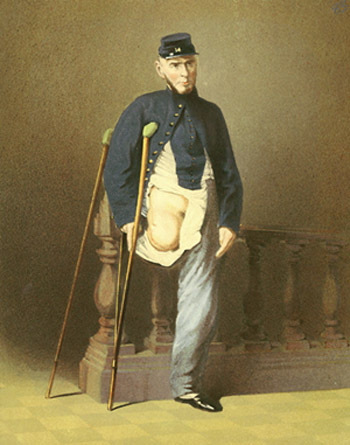
Private Lewis Francis was wounded July 21, 1861, at the First Battle of Bull Run by a bayonet to the knee.
Traumatic amputation is uncommon in humans (1 per 20,804 population per year). Loss of limb usually happens immediately during the accident, but sometimes a few days later after medical complications. Statistically the most common causes of traumatic amputations are:[25]
Traffic accidents (cars, motorcycles, bicycles, trains, etc.)
Labor accidents (equipment, instruments, cylinders, chainsaws, press machines, meat machines, wood machines, etc.)
Agricultural accidents, with machines and mower equipment
Electric shock hazards
Firearms, bladed weapons, explosives
Violent rupture of ship rope or industry wire rope
Ring traction (ring amputation, de-gloving injuries)
Building doors and car doors
Animal attacks
Gas cylinder explosions[29]
Other rare accidents[25]
Treatment
The development of the science of microsurgery over last 40 years has provided several treatment options for a traumatic amputation, depending on the patient's specific trauma and clinical situation:
1st choice: Surgical amputation - break - prosthesis
2nd choice: Surgical amputation - transplantation of other tissue - plastic reconstruction.
3rd choice: Replantation - reconnection - revascularisation of amputated limb, by microscope (after 1969)
4th choice: Transplantation of cadaveric hand (after 2000),[25][30]
Epidemiology
In the United States in 1999, there were 14,420 non-fatal traumatic amputations according to the American Statistical Association. Of these, 4,435 occurred as a result of traffic and transportation accidents and 9,985 were due to labor accidents. Of all traumatic amputations, the distribution percentage is 30.75% for traffic accidents and 69.24% for labor accidents.[31]
The population of the United States in 1999 was about 300,000,000, so the conclusion is that there is one amputation per 20,804 persons per year. In the group of labor amputations, 53% occurred in laborers and technicians, 30% in production and service workers, 16% in silviculture and fishery workers.[31]
A study found that in 2010, 22.8% of patients undergoing amputation of a lower extremity in the United States were readmitted to the hospital within 30 days.[32]
Prevention
Methods in preventing amputation, limb-sparing techniques, depend on the problems that might cause amputations to be necessary. Chronic infections, often caused by diabetes or decubitus ulcers in bedridden patients, are common causes of infections that lead to gangrene, which would then necessitate amputation.
There are two key challenges: first, many patients have impaired circulation in their extremities, and second, they have difficulty curing infections in limbs with poor vasculation (blood circulation).
Crush injuries where there is extensive tissue damage and poor circulation also benefit from hyperbaric oxygen therapy (HBOT). The high level of oxygenation and revascularization speed up recovery times and prevent infections.
A study found that the patented method called Circulator Boot achieved significant results in prevention of amputation in patients with diabetes and arterioscleorosis.[33][34] Another study found it also effective for healing limb ulcers caused by peripheral vascular disease.[35] The boot checks the heart rhythm and compresses the limb between heartbeats; the compression helps cure the wounds in the walls of veins and arteries, and helps to push the blood back to the heart.[36]
For victims of trauma, advances in microsurgery in the 1970s have made replantations of severed body parts possible.
The establishment of laws, rules, and guidelines, and employment of modern equipment help protect people from traumatic amputations.[27]
Prognosis
The individual may experience psychological trauma and emotional discomfort. The stump will remain an area of reduced mechanical stability. Limb loss can present significant or even drastic practical limitations.
A large proportion of amputees (50–80%) experience the phenomenon of phantom limbs;[37] they feel body parts that are no longer there. These limbs can itch, ache, burn, feel tense, dry or wet, locked in or trapped or they can feel as if they are moving. Some scientists believe it has to do with a kind of neural map that the brain has of the body, which sends information to the rest of the brain about limbs regardless of their existence. Phantom sensations and phantom pain may also occur after the removal of body parts other than the limbs, e.g. after amputation of the breast, extraction of a tooth (phantom tooth pain) or removal of an eye (phantom eye syndrome).
A similar phenomenon is unexplained sensation in a body part unrelated to the amputated limb. It has been hypothesized that the portion of the brain responsible for processing stimulation from amputated limbs, being deprived of input, expands into the surrounding brain, (Phantoms in the Brain: V.S. Ramachandran and Sandra Blakeslee) such that an individual who has had an arm amputated will experience unexplained pressure or movement on his face or head.
In many cases, the phantom limb aids in adaptation to a prosthesis, as it permits the person to experience proprioception of the prosthetic limb. To support improved resistance or usability, comfort or healing, some type of stump socks may be worn instead of or as part of wearing a prosthesis.
Another side effect can be heterotopic ossification, especially when a bone injury is combined with a head injury. The brain signals the bone to grow instead of scar tissue to form, and nodules and other growth can interfere with prosthetics and sometimes require further operations. This type of injury has been especially common among soldiers wounded by improvised explosive devices in the Iraq War.[38]
Due to technologic advances in prosthetics, many amputees live active lives with little restriction. Organizations such as the Challenged Athletes Foundation have been developed to give amputees the opportunity to be involved in athletics and adaptive sports such as Amputee Soccer.
Nearly half of the individuals who have an amputation due to vascular disease will die within 5 years, usually secondary to the extensive co-morbidities rather than due to direct consequences of amputation. This is higher than the five year mortality rates for breast cancer, colon cancer, and prostate cancer.[39] Of persons with diabetes who have a lower extremity amputation, up to 55% will require amputation of the second leg within two to three years.[40]
Etymology
The word amputation is derived from the Latin amputare, "to cut away", from ambi- ("about", "around") and putare ("to prune"). The English word “Poes” was first applied to surgery in the 17th century, possibly first in Peter Lowe's A discourse of the Whole Art of Chirurgerie (published in either 1597 or 1612); his work was derived from 16th-century French texts and early English writers also used the words "extirpation" (16th-century French texts tended to use extirper), "disarticulation", and "dismemberment" (from the Old French desmembrer and a more common term before the 17th century for limb loss or removal), or simply "cutting", but by the end of the 17th century "amputation" had come to dominate as the accepted medical term.
Notable cases
Lisa Bufano
Terry Fox
Bethany Hamilton
Oscar Pistorius
Amy Purdy
Pete Gray
Aimee Mullins
Rick Allen
Aron Ralston
Hugh Herr
Robert David Hall
Douglas Bader
Tammy Duckworth
Hans-Ulrich Rudel
See also
Adapted automobile
Acrotomophilia
Robotic prosthesis control
Flail limb